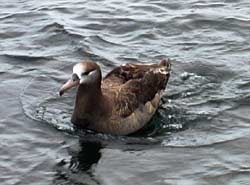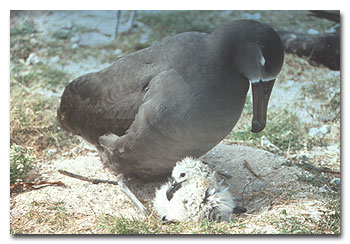Black-footed Albatross

Common Name: Black-footed Albatross
Scientific Name: Phoebastria nigripes
Description
The Laysan Albatross and Black-footed Albatross are two of the 3 species of albatross that occur in Alaskan waters. Albatrosses are by far the largest seabirds found in Alaska, but are small compared to many other albatrosses. Laysan, Black-footed, and Short-tailed Albatross have a wingspan of almost two meters, which is half that of the largest albatrosses. Albatrosses do not nest in Alaska but they migrate here each year after having bred in such far away places as the Northwestern Hawaiian Islands and Torishima Island in Japan.
On these remote uninhabited islands, albatrosses nest in huge, dense colonies. Nearly all of the 400,000 breeding pairs of Laysan Albatross and 50,000 pairs of Black-footed Albatross nest in the Northwestern Hawaiian Islands. The Latin family name for albatrosses is Diomedeidae, which comes from the name of the Greek hero of the Trojan War, Diomedes. The Greek gods exiled Diomedes to an isolated island and turned all of his companions into large, white birds resembling swans

Life History
Reproduction Comments: Single egg is laid mid-November to early December on Midway Island. Incubation, in long turns by both sexes, lasts 63-68 days. Young are tended by both sexes. Nestling stage lasts about 140 days. May not breed until 5+ years old. Life-long pair bond. Does not renest if egg is lost.
Habitat
Marine Habitat(s): Near shore, Pelagic
Terrestrial Habitat(s): Sand/dune
Habitat Comments: Pelagic. Frequently follows ships. Nests in sand on oceanic islands. Usually nests in same spot in successive years.
Location or Region Found
Albatrosses are truly at home soaring over the open ocean. Since the first humans encountered albatrosses at sea, they have marveled at their mastery of the ocean despite the harshest North Pacific storms.
Breeding
Today, most of the breeding sites of North Pacific albatrosses have been preserved and it is illegal to intentially kill albatross. However many Laysan and Black-footed albatross are killed every year as a result of human activities. Long-line fishing is one of the causes, but this problem may be small compared to others. When albatross see small pieces of plastic floating on the surface of the water they will often mistake them for food and eat them. This plastic builds up inside the bird and can eventually prevent the bird from feeding properly.
Breeding colonies are often covered in plastic debris and piles of plastic mark where birds have died and their bodies have decomposed. There is also concern for the levels of some toxic pollutants in the bodies of albatrosses.
 Deep Sea Crabs
Deep Sea Crabs